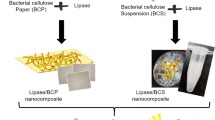Abstract
The adsorption of a carbohydrate binding module (CBM3) from the Clostridium thermocellum scaffolding protein (CipA) to cellulose was analysed in this work. The effect of CBM-PEG on the drainability of E. globulus and P. sylvestris pulps and on the physical properties of the respective papersheets was also studied. The CBM binding to cellulose is often described as “irreversible”, but this classification does not fully characterize this interaction. Indeed, the results obtained demonstrate that, although the adsorption on cellulose is rather stable, CBM inter-fibre mobility may be observed. The results also showed that the CBM-PEG conjugate improves the drainability of E. globulus and P. sylvestris pulps without affecting the physical properties of the papersheets.





Similar content being viewed by others
References
Abushowski A, McCoy JR, Palczuk NC, Van Es T, Davis FF (1977) Effect of covalent attachment of poly(ethylene glycol) on immunogenicity and circulating life of bovine liver catalase. J Biol Chem 252(11):3582–3586
Bailon P, Berthold W (1998) Polyethylene glycol-conjugated pharmaceutical proteins. Pharm Sci Technol Today 1(8):352–356. doi:10.1016/S1461-5347(98)00086-8
Fontes CM, Hazlewood GP, Morag E, Hall J, Hirst BH, Gilbert HJ (1995) Evidence for a general role for non catalytic thermostabilizing domains in xylanases from thermophilic bacteria. Biochem J 307:151–158
Fontes CM, Ponte PI, Reis TC, Soares MC, Gama LT, Dias FM, Ferreira LM (2004) A family 6 carbohydrate-binding module potentiates the efficiency of a recombinant xylanase used to supplement cereal-based diets for poultry. Br Poult Sci 45(5):648–656. doi:10.1080/00071660400006362
Geng X, Li K (2003) Deiking of recycle mixed office paper using two endoglucanases, CelB and CelE, from anaerobic fungus Orpinomyces PC-2. TAPPI J 2:29–32
Jackson LS, Heitmann JA, Joyce TW (1993) Enzymatic modifications of secondary fibers. TAPPI J 76:147–154
Jervis EJ, Haynes CA, Kiburn DG (1997) Surface diffusion of cellulases and their isolated binding domains on cellulose. J Biol Chem 272:24016–24023. doi:10.1074/jbc.272.38.24016
Kataeva IA, Li X-L, Chen H, Choi S-K, Ljungdahl LG (1999) Cloning and sequence analysis of a new cellulase gene encoding CelK, a major cellulosome component of Clostridium thermocellum: evidence of gene duplication and recombination. J Bacteriol 181:5288–5295
Kataeva IA, Siedel RDIII, LI X-L, Ljungdahl LG (2001) Properties and mutation analysis of the CelK cellulose-binding domain from the Clostridium thermocellum cellulosome. J Bacteriol 183(5):1552–1559. doi:10.1128/JB.183.5.1552-1559.2001
Kitaoka T, Tanaka H (2001) Novel paper strength additive containing cellulose binding domain of cellulose. J Wood Sci 47:322–324. doi:10.1007/BF00766721
Klyosov AA, Sinitsyn AP (1981) Enzymatic hydrolysis of cellulose. IV. Effect of major physico-chemical and structural features of the substrate. Bioorg Chem 7:1801–1812
Levy I, Nussinovitch A, Shpigel E, Shoseyov O (2002) Recombinant cellulose crosslinking protein: a novel paper- modification biomaterial. Cellulose 9:91–98. doi:10.1023/A:1015848701029
Najmudin S, Guerreiro C, Ferreira L, Romão MJ, Fontes CM, Prates JA (2005) Overexpression, purification and crystallization of the two C-terminal domains of the bifunctional cellulose ctCel9D-Cell44A from Clostridium thermocellum. Acta Crystallogr F61:1043–1045
Pala H, Lemos MA, Mota M, Gama FM (2001) Enzymatic upgrade of old paperboard containers. Enzyme Microb Technol 29:274–279. doi:10.1016/S0141-0229(01)00380-5
Pinto R, Moreira S, Mota M, Gama FM (2004) Studies on the cellulose-binding domains adsorption to cellulose. Langmuir 20:1409–1413. doi:10.1021/la035611u
Pinto R, Amaral AL, Carvalho J, Ferreira EC, Mota M, Gama FM (2007) Development of a method using image analysis and CBD-FITC conjugates for the measurement of CBDs adsorbed onto cellulose fibers. Biotechnol Prog 23(6):1492–1497. doi:10.1021/bp070026v
Pinto R, Amaral AL, Ferreira EC, Mota M, Vilanova M, Ruel K, Gama FM (2008) Quantification of the CBD-FITC conjugates surface coating on cellulose fibres. BMC Biotechnol 8:1. doi:10.1186/1472-6750-8-1
Ramos R, Pinto R, Sampaio L, Mota M, Gama FM (2007) Textile depilling: superior finishing using cellulose binding domains with residual enzyme activity. Biocatal Biotransform 25(1):35–42
Senior DJ, Hamilton J (1993) Xylanase treatment for the bleaching of softwood kraft pulps: the effect of chlorine dioxide substitution. TAPPI J 76:200–206
Seo YB, Shin IC, Jeon Y (2000) Enzymatic and mechanical treatment on chemical pulp. TAPPI J 83:1–9
Shoseyov O, Warren RAJ (1997) Cellulose binding domains—a novel fusion technology for efficient, low cost purification and immobilization of recombinant proteins, innovations, No. 7
Shoseyov O, Shani Z, Levy I (2006) Carbohydrate binding modules: biochemical properties and novel applications. Microbiol Mol Biol Rev 70(2):283–295. doi:10.1128/MMBR.00028-05
Suurnäki A, Kantelinen A, Buchert J, Viikari L (1994) Enzyme-aided bleaching of industrial softwood kraft pulps. TAPPI J 77:111–116
Xie H, Gilbert HJ, Charnock SJ, Davies GJ, Williamson MP, Simpson PJ, Rahgothama S, Fontes CM, Dias FM, Ferreira LM, Bolam DN (2001) Clostridium thermocellum Xyn10B carbohydrate-binding module 22–2: the role of conserved amino acids in lingind binding. Biochemistry 40:9167–9176
Acknowledgments
This research was supported by Fundação para a Ciência e a Tecnologia under grant POCTI/BIO/45356/2002.
Author information
Authors and Affiliations
Corresponding author
Rights and permissions
About this article
Cite this article
Machado, J., Araújo, A., Pinto, R. et al. Studies on the interaction of the carbohydrate binding module 3 from the Clostridium thermocellum CipA scaffolding protein with cellulose and paper fibres. Cellulose 16, 817–824 (2009). https://doi.org/10.1007/s10570-009-9294-0
Received:
Accepted:
Published:
Issue Date:
DOI: https://doi.org/10.1007/s10570-009-9294-0




